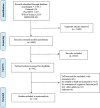Effects of neighborhood built environment on cognitive function in older adults: a systematic review
- PMID: 38408919
- PMCID: PMC10898015
- DOI: 10.1186/s12877-024-04776-x
Effects of neighborhood built environment on cognitive function in older adults: a systematic review
Abstract
Background: In the background of an aging population, the risk of cognitive impairment in the older population is prominent. Exposure to complex neighborhood built environments may be beneficial to the cognitive health of older adults, and the purpose of this study was to systematically review the scientific evidence on the effects of neighborhood built environments on cognitive function in older adults.
Methods: Keywords and references were searched in Web of Science, Pubmed, PsycINFO, and MEDLINE. Studies examining the relationship between the built environment and cognitive function in older adults were included. The neighborhood built environment as an independent variable was classified according to seven aspects: density, design, diversity, destination accessibility, public transportation distance, blue/green space, and built environment quality. The cognitive function as the dependent variable was classified according to overall cognitive function, domain-specific cognitive function, and incidence of dementia. The quality of the included literature was assessed using the National Institutes of Health's Observational Cohort and Cross-Sectional Study Quality Assessment Tool.
Results: A total of 56 studies were included that met the inclusion criteria, including 31 cross-sectional studies, 23 longitudinal studies, 1 cross-sectional study design combined with a case-control design, and 1 longitudinal study design combined with a case-control design. Most of the studies reviewed indicate that the built environment factors that were positively associated with cognitive function in older adults were population density, street connectivity, walkability, number of public transportation stops around the residence, land use mix, neighborhood resources, green space, and quality of the neighborhood built environment. Built environment factors that were negatively associated with cognitive function in older adults were street integration, distance from residence to main road. The relationship between residential density, destination accessibility, and blue space with cognitive function in older adults needs to be further explored.
Conclusion: Preliminary evidence suggests an association between the neighborhood built environment and cognitive function in older adults. The causal relationship between the built environment and cognitive function can be further explored in the future using standardized and combined subjective and objective assessment methods, and longitudinal or quasi-experimental study designs. For public health interventions on the cognitive health of older adults, it is recommended that relevant authorities include the neighborhood built environment in their intervention programs.
Keywords: Built environment; Cognitive function; Neighborhood; Older adults; Systematic review.
© 2024. The Author(s).
Conflict of interest statement
The authors declare no competing interests.
Similar articles
-
The Neighborhood Built Environment and Cognitive Function of Older Persons: Results from the Singapore Longitudinal Ageing Study.Gerontology. 2018;64(2):149-156. doi: 10.1159/000480080. Epub 2017 Sep 15. Gerontology. 2018. PMID: 28910813
-
Association between the perceived built environment and health behaviors in older adults: a cross-sectional study from Beijing, China.BMC Geriatr. 2024 Aug 19;24(1):692. doi: 10.1186/s12877-024-05285-7. BMC Geriatr. 2024. PMID: 39160474 Free PMC article.
-
Neighbourhood environments and cognitive health in the longitudinal Personality and Total Health (PATH) through life study: A 12-year follow-up of older Australians.Environ Int. 2024 Sep;191:108984. doi: 10.1016/j.envint.2024.108984. Epub 2024 Aug 25. Environ Int. 2024. PMID: 39208561
-
Impact of the Built Environment and the Neighborhood in Promoting the Physical Activity and the Healthy Aging in Older People: An Umbrella Review.Int J Environ Res Public Health. 2020 Aug 23;17(17):6127. doi: 10.3390/ijerph17176127. Int J Environ Res Public Health. 2020. PMID: 32842526 Free PMC article.
-
Neighborhood Built Environments and Health in Later Life: A Literature Review.J Aging Health. 2025 Jan;37(1-2):3-17. doi: 10.1177/08982643231217776. Epub 2023 Nov 23. J Aging Health. 2025. PMID: 37994863 Free PMC article. Review.
Cited by
-
Distance from home and working memory: daily associations varying by neighborhood environments in community-dwelling older adults.Eur J Ageing. 2025 Apr 5;22(1):17. doi: 10.1007/s10433-025-00841-5. Eur J Ageing. 2025. PMID: 40186720 Free PMC article.
-
Cognitive Health Costs of Poor Housing for Women: Exploring Executive Function and Housing Stress in Urban Slums in India.Int J Environ Res Public Health. 2024 Dec 23;21(12):1710. doi: 10.3390/ijerph21121710. Int J Environ Res Public Health. 2024. PMID: 39767549 Free PMC article.
-
Frail older people ageing in place alone and their perception of the built environment in rural and urban sites: a mixed-methods study.BMC Geriatr. 2025 Jul 2;25(1):457. doi: 10.1186/s12877-025-06083-5. BMC Geriatr. 2025. PMID: 40604583 Free PMC article.
-
Fine Particulate Matter Is Associated With Lower Executive Functioning in Middle-aged and Older Adults: Cardiometabolic Disease as a Mediator.J Gerontol A Biol Sci Med Sci. 2025 Jun 10;80(7):glaf104. doi: 10.1093/gerona/glaf104. J Gerontol A Biol Sci Med Sci. 2025. PMID: 40341984 Free PMC article.
References
-
- He W, Goodkind D, Kowal P. An aging world: 2015;2016.
-
- Kumar A, Sidhu J, Goyal A, Tsao JW. Alzheimer Disease. In: StatPearls. Treasure Island: StatPearls Publishing Copyright © 2023, StatPearls Publishing LLC.; 2023.
-
- Leon-Salas B, Ayala A, Blaya-Novakova V, Avila-Villanueva M, Rodriguez-Blazquez C, Rojo-Perez F, Fernandez-Mayoralas G, Martinez-Martin P, Forjaz MJ, Spanish Research Group on Quality of L et al. Quality of life across three groups of older adults differing in cognitive status and place of residence. Geriatr Gerontol Int. 2015;15(5):627–635. doi: 10.1111/ggi.12325. - DOI - PubMed
-
- Liang Y, Yang Y, Yang T, Li M, Ruan Y, Jiang Y, Huang Y, Wang Y. Effects of cognitive impairment and depressive symptoms on health-related quality of life in community-dwelling older adults: The mediating role of disability in the activities of daily living and the instrumental activities of daily living. Health Soc Care Commun. 2022;30(6):e5848–e5862. doi: 10.1111/hsc.14016. - DOI - PubMed
Publication types
MeSH terms
Grants and funding
LinkOut - more resources
Full Text Sources
Miscellaneous


